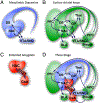FACTORS CONTRIBUTING TO THE ESCALATION OF ALCOHOL CONSUMPTION
- PMID: 34839930
- PMCID: PMC8892842
- DOI: 10.1016/j.neubiorev.2021.11.017
FACTORS CONTRIBUTING TO THE ESCALATION OF ALCOHOL CONSUMPTION
Abstract
Understanding factors that contribute to the escalation of alcohol consumption is key to understanding how an individual transitions from non/social drinking to AUD and to providing better treatment. In this review, we discuss how the way ethanol is consumed as well as individual and environmental factors contribute to the escalation of ethanol consumption from intermittent low levels to consistently high levels. Moreover, we discuss how these factors are modelled in animals. It is clear a vast array of complex, interacting factors influence changes in alcohol consumption. Some of these factors act early in the acquisition of ethanol consumption and initial escalation, while others contribute to escalation of ethanol consumption at a later stage and are involved in the development of alcohol dependence. There is considerable need for more studies examining escalation associated with the formation of dependence and other hallmark features of AUD, especially studies examining mechanisms, as it is of considerable relevance to understanding and treating AUD.
Keywords: alcohol; alcohol dependence; alcohol deprivation effect; alcohol use disorder; alcohol withdrawal; alcoholic; alcoholism; continuous ethanol access; drinking in the dark; ethanol; incubation of craving; intermittent ethanol access; social anxiety; social isolation; sucrose fading.
Copyright © 2021 Elsevier Ltd. All rights reserved.
Conflict of interest statement
Declaration of Competing Interest
MTB is listed as an inventor on patents for novel oxytocin-based therapeutic candidates and for therapeutic candidates for alcohol use disorder and is co-founder and chief scientific officer of a company, Kinoxis Therapeutics Pty Ltd, commercialising some of this technology. The other authors declare they have no conflicts of interest.
Figures



References
-
- Agabio R, Carai MA, Lobina C, Pani M, Reali R, Vacca G, Gessa GL, Colombo G, 2000. Development of short-lasting alcohol deprivation effect in sardinian alcohol-preferring rats. Alcohol 21, 59–62. - PubMed
-
- Agarwal DP, Goedde HW, 1992. Pharmacogenetics of alcohol metabolism and alcoholism. Pharmacogenetics 2, 48–62. - PubMed
-
- Åkerlind I, Hörnquist JO, 1992. Loneliness and alcohol abuse: A review of evidences of an interplay. Social Science & Medicine 34, 405–414. - PubMed
-
- Allan AM, Harris RA, 1986. Gamma-aminobutyric acid and alcohol actions: neurochemical studies of long sleep and short sleep mice. Life sciences 39, 2005–2015. - PubMed
-
- Amancio-Belmont O, Becerril Meléndez AL, Ruiz-Contreras AE, Méndez-Díaz M, Prospéro-García O, 2020. Maternal separation plus social isolation during adolescence reprogram brain dopamine and endocannabinoid systems and facilitate alcohol intake in rats. Brain Research Bulletin 164, 21–28. - PubMed

